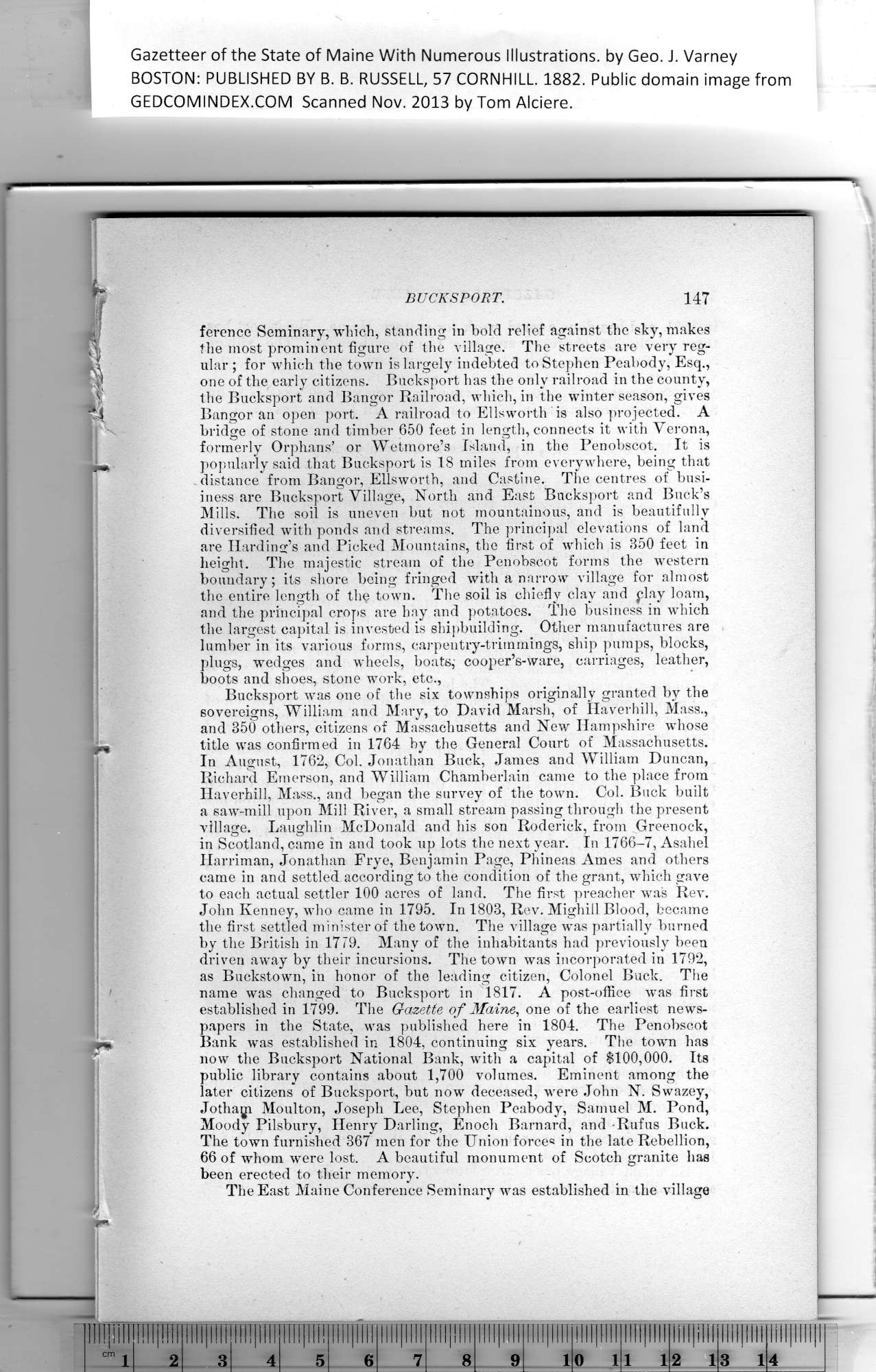|
Gazetteer of the State of Maine With Numerous Illustrations, by Geo. J. Varney
BOSTON: PUBLISHED BY B. B. RUSSELL, 57 CORNHILL. 1882. Public domain image from
BUCKSPORT. 147
ference Seminary, which, standing in bold relief against the sky, makes
the most prominent figure of the village. The streets are very reg-
ular ; for which the town is largely indebted to Stephen Peabody, Esq.,
one of the early citizens. Bucksport has the only railroad in the county,
the Bucksport and Bangor Railroad, which, in the winter season, gives
Bangor an open port. A railroad to Ellsworth is also projected. A
bridge of stone and timber 650 feet in length, connects it with Verona,
formerly Orphans’ or Wetmore’s Island, in the Penobscot. It is
popularly said that Bucksport is 18 miles from everywhere, being that
distance from Bangor, Ellsworth, and Castine. The centres of busi-
iness are Bucksport Village, North and East Bucksport and Buck’s
Mills. The soil is uneven but not mountainous, and is beautifully
diversified with ponds and streams. The principal elevations of land
are Harding’s and Picked Mountains, the first of which is 850 feet in
height. The majestic stream of the Penobscot forms the western
boundary; its shore being fringed with a narrow village for almost
the entire length of the town. The soil is chiefly clay and play loam,
and the principal crops are hay and potatoes. The business in which
the largest capital is invested is shipbuilding. Other manufactures are
lumber in its various forms, carpentry-trimrnings, ship pumps, blocks,
plugs, wedges and wheels, boats, cooper’s-ware, carriages, leather,
boots and shoes, stone work, etc.,
Bucksport was one of the six townships originally granted by the
sovereigns, William and Mary, to David Marsh, of Haverhill, Mass.,
and 350 others, citizens of Massachusetts and New Hampshire whose
title was confirmed in 1764 hy the General Court of Massachusetts.
In August, 1762, Col. Jonathan Buck, James and William Duncan,
Richard Emerson, and William Chamberlain came to the place from
Haverhill, Mass., and began the survey of the town. Col. Buck built
a saw-mill upon Mill River, a small stream passing through the present
village. Laughlin McDonald and his son Roderick, from Greenock,
in Scotland, came in and took up lots the next year. In 1766-7, Asahel
ITarriman, Jonathan Frye, Benjamin Page, Phineas Ames and others
came in and settled according to the condition of the grant, which gave
to each actual settler 100 acres of land. The first preacher was Rev.
John Kenney, who came in 1795. In 1803, Rev. Mighiil Blood, became
the first settled minister of the town. The village was partially burned
by the British in 1779. Many of the inhabitants had previously been
driven away by their incursions. The town was incorporated in 1792,
as Buckstown, in honor of the leading citizen, Colonel Buck. The
name was changed to Bucksport in 1817. A post-office wTas first
established in 1799. The Gazette of Maine, one of the earliest news-
papers in the State, was published here in 1804. The Penobscot
Bank was established in 1804, continuing six years. The towm has
now the Bucksport National Bank, with a capital of $100,000. Its
public library contains about 1,700 volumes. Eminent among the
later citizens of Bucksport, but now deceased, were John N. Swazey,
Jothagi Moulton, Joseph Lee, Stephen Peabody, Samuel M. Pond,
Moody Pilsbury, Henry Darling, Enoch Barnard, and -Rufus Buck.
The town furnished 367 men for the Union forces iu the late Rebellion,
66 of whom were lost. A beautiful monument of Scotch granite has
been erected to their memory.
The East Maine Conference Seminary was established in tbe village
PREVIOUS PAGE ... NEXT PAGE
This page was written in HTML using a program written in Python 3.2
|
